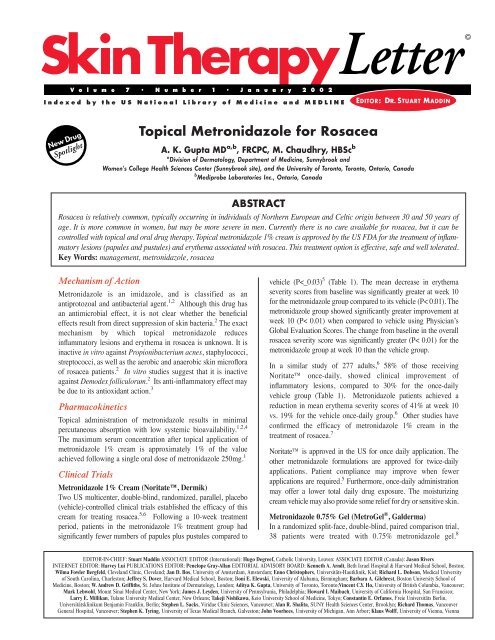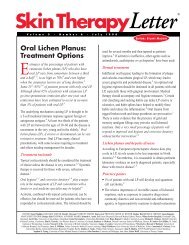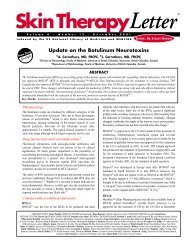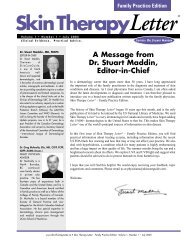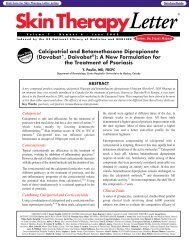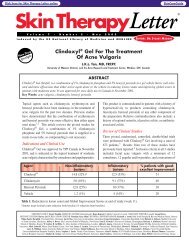Topical Metronidazole for Rosacea - Skin Therapy Letter
Topical Metronidazole for Rosacea - Skin Therapy Letter
Topical Metronidazole for Rosacea - Skin Therapy Letter
You also want an ePaper? Increase the reach of your titles
YUMPU automatically turns print PDFs into web optimized ePapers that Google loves.
V o l u m e 7 • N u m b e r 1 • J a n u a r y 2 0 0 2<br />
Indexed by the US National Library of Medicine and MEDLINE<br />
<strong>Topical</strong> <strong>Metronidazole</strong> <strong>for</strong> <strong>Rosacea</strong><br />
A. K. Gupta MD a,b , FRCPC, M. Chaudhry, HBSc b<br />
a Division of Dermatology, Department of Medicine, Sunnybrook and<br />
Women’s College Health Sciences Center (Sunnybrook site), and the University of Toronto, Toronto, Ontario, Canada<br />
b Mediprobe Laboratories Inc., Ontario, Canada<br />
ABSTRACT<br />
<strong>Rosacea</strong> is relatively common, typically occurring in individuals of Northern European and Celtic origin between 30 and 50 years of<br />
age. It is more common in women, but may be more severe in men. Currently there is no cure available <strong>for</strong> rosacea, but it can be<br />
controlled with topical and oral drug therapy. <strong>Topical</strong> metronidazole 1% cream is approved by the US FDA <strong>for</strong> the treatment of inflammatory<br />
lesions (papules and pustules) and erythema associated with rosacea. This treatment option is effective, safe and well tolerated.<br />
Key Words: management, metronidazole, rosacea<br />
Mechanism of Action<br />
<strong>Metronidazole</strong> is an imidazole, and is classified as an<br />
antiprotozoal and antibacterial agent. 1,2 Although this drug has<br />
an antimicrobial effect, it is not clear whether the beneficial<br />
effects result from direct suppression of skin bacteria. 2 The exact<br />
mechanism by which topical metronidazole reduces<br />
inflammatory lesions and erythema in rosacea is unknown. It is<br />
inactive in vitro against Propionibacterium acnes, staphylococci,<br />
streptococci, as well as the aerobic and anaerobic skin microflora<br />
of rosacea patients. 2 In vitro studies suggest that it is inactive<br />
against Demodex folliculorum. 2 Its anti-inflammatory effect may<br />
be due to its antioxidant action. 3<br />
Pharmacokinetics<br />
<strong>Topical</strong> administration of metronidazole results in minimal<br />
percutaneous absorption with low systemic bioavailability. 1,2,4<br />
The maximum serum concentration after topical application of<br />
metronidazole 1% cream is approximately 1% of the value<br />
achieved following a single oral dose of metronidazole 250mg. 1<br />
Clinical Trials<br />
<strong>Metronidazole</strong> 1% Cream (Noritate, Dermik)<br />
Two US multicenter, double-blind, randomized, parallel, placebo<br />
(vehicle)-controlled clinical trials established the efficacy of this<br />
cream <strong>for</strong> treating rosacea. 5,6 Following a 10-week treatment<br />
period, patients in the metronidazole 1% treatment group had<br />
significantly fewer numbers of papules plus pustules compared to<br />
vehicle (P
Following nine weeks of twice daily application of metronidazole<br />
gel to one side of the face and vehicle to the other, there was a<br />
mean reduction of 65.1% and 14.9%, respectively, from baseline<br />
in total papules and pustules. 8 The reduction in erythema scores<br />
at week 9 on the metronidazole side was significantly different<br />
from scores on the placebo side (P=0.0006). 8<br />
Another clinical trial studied 19 patients with severe or<br />
recalcitrant rosacea. 9 Patients were treated twice daily with<br />
MetroGel ® , and efficacy was determined based upon the<br />
following criteria: inflammatory lesion (papules and pustules)<br />
counts, clinical assessment of erythema and edema, and<br />
Investigator Global Assessment. The number of inflammatory<br />
lesions decreased from a mean of 20 at baseline to 7 at week 8<br />
(P
Product/ Study n App. Results<br />
Investigator<br />
<strong>Metronidazole</strong> 1% Multicenter, double-blind, 139 qd <strong>for</strong> 10 Overall rosacea severity score significantly<br />
Cream: randomized, parallel, 1% cream vs. wks greater <strong>for</strong> 1% metronidazole cream group.<br />
Noritate ® (Dermik) placebo<br />
• Breneman, et al 5<br />
• Jorizzo, et al 6 Multicenter, double-blind, 277 qd or bid Using Physician’s Global Assessment<br />
randomized, parallel, 1% cream once <strong>for</strong> 10 wks Scores the metronidazole qd group rated<br />
daily vs. 1% cream twice daily vs.<br />
fair/better improvement (79%) vs. baseline<br />
placebo<br />
(p50% within 1<br />
bid <strong>for</strong> 2 mos month of treatment (P
Treatments Of Choice For Bullous Pemphigoid<br />
S.M. Cooper MD and F. Wojnarowska, MD<br />
Department of Dermatology, Ox<strong>for</strong>d Radcliffe Hospital, Ox<strong>for</strong>d, UK<br />
ABSTRACT<br />
Bullous pemphigoid (BP) is the most frequently occurring autoimmune blistering disease in Europe and North America. Although<br />
it is primarily a disease of the elderly, children and young adults can also develop it. The aim of treatment is to suppress the clinical<br />
signs and symptoms of BP without over-treating the patient, because BP tends to spontaneously remit in most patients within<br />
approximately 5 years. Mild or localized disease may respond to super-potent topical corticosteroids alone or in combination with<br />
tetracyclines with or without niacinamide. More severe or generalized disease usually requires systemic treatment with prednisolone<br />
(dose range from 20-70mg/d). Additional immunosuppressant therapy is necessary <strong>for</strong> more refractory disease.<br />
Key Words: bullous pemphigoid, autoimmune disease<br />
Clinical Presentation and Diagnosis of<br />
Bullous Pemphigoid<br />
BP is a non-scarring blistering disease. 1,2 Tense blisters may arise<br />
on normal appearing skin or on erythematous plaques. Blistering<br />
may be widespread or occur in one site, typically a flexural site.<br />
The involvement of mucous membranes occurs in approximately<br />
half of patients. Occasionally an urticarial or eczematous rash<br />
may precede blister <strong>for</strong>mation by months or years.<br />
Diagnosis is made by considering the clinical picture, histology and<br />
immunofluorescence results. A typical biopsy of a new blister shows<br />
a subepidermal cleft with a mixed dermal inflammatory infiltrate<br />
containing many eosinophils. Direct immunofluorescence of<br />
perilesional skin reveals linear deposits of IgG and/or C3 (rarely IgA,<br />
IgM or IgE), and indirect immunofluorescence of serum or blister<br />
fluid demonstrates linear IgG at the basement membrane zone.<br />
Principles of Treatment<br />
There are few randomized, controlled trials of therapy <strong>for</strong> BP,<br />
thus in<strong>for</strong>mation comes mostly from case series, case reports and<br />
clinical experience. There are still many unanswered questions.<br />
Clinicians differ in their approach to management. Here, we<br />
outline our approach:<br />
BP is self-limiting, usually remitting within 5 years, thus it is<br />
important not to overtreat the disease. Many of the drugs <strong>for</strong> BP<br />
are potentially hazardous. Drug interactions and side effects are<br />
more frequent in the elderly, so that the treatment may be more<br />
dangerous than the disease. We favor the use of the minimum<br />
doses of systemic therapy to control the disease, modifying the<br />
treatment on an individual basis, taking account of the age and<br />
general health of the patient and the extent of the disease. Some<br />
will have more aggressive disease and need significant<br />
immunosuppression. Once control of BP has been achieved,<br />
treatment can be gradually tapered off. In practice, treatment<br />
should be reduced whenever the disease has been well controlled<br />
<strong>for</strong> a month. It is not necessary to completely suppress all blister<br />
<strong>for</strong>mation. The occurrence of an occasional blister ensures that<br />
the patient is not being over treated.<br />
Mechanisms of Treatment<br />
Treatments <strong>for</strong> bullous pemphigoid comprise three categories: antiinflammatories,<br />
immunosuppressants, and immune-modulators.<br />
Anti-inflammatory drugs, e.g., corticosteroids and antibiotics aim to<br />
suppress the inflammatory process. Immunosuppressant drugs aim<br />
to suppress the production of circulating pathogenic antibodies and<br />
include high dose corticosteroids, azathioprine, methotrexate,<br />
ciclosporin and cyclophosphamide. Intravenous immunoglobulin is<br />
an immune modulator.<br />
Systemic Steroids<br />
The use of systemic corticosteroids is well established although<br />
optimum treatment doses are still a subject of debate. Initial<br />
treatment doses should take disease severity into account. In<br />
localized or mild disease 20mg/d of prednisolone (0.3 mg/kg/d) is<br />
sufficient, and <strong>for</strong> moderate disease 40mg/d or 0.6mg/kg/d. Higher<br />
doses of 50-70mg or 0.75-1.0mg/kg/d are indicated in severe<br />
disease. Treatment with more than 30mg of prednisolone (0.75<br />
mg/kg) daily is associated with significant mortality and must be<br />
tapered as soon as possible. 3 However, more severe disease may<br />
take longer to come under control. It is important to consider<br />
prevention of osteoporosis when steroid treatment is commenced.<br />
<strong>Topical</strong> Steroids<br />
<strong>Topical</strong> superpotent steroids, e.g., clobetasol proprionate 0.05%<br />
have a role in treating localized and mild-to-moderate generalized<br />
disease. 4 In localized and sometimes in generalized disease this<br />
treatment alone may suffice. <strong>Topical</strong> steroids can be a useful adjunct<br />
to systemic treatment in severe disease, aiding control of symptoms.<br />
Antibiotics and Nicotinamide<br />
Antibiotics and niacinamide (nicotinamide) are useful first line<br />
treatments that may spare some patients from<br />
immunosuppressant therapy. 5 Tetracyclines (oxytetracycline,<br />
minocycline or doycycline) may be prescribed as sole agents or<br />
in combination with niacinamide. In local or mild disease,<br />
tetracyclines may provide disease control without resorting to<br />
systemic prednisolone. In moderate disease, tetracyclines in<br />
combination with prednisolone may have a steroid sparing<br />
action. We use minocycline (50-100mg/d) or oxytetracycline<br />
(500-1000mg/d) when minocycline-induced pigmentation is a<br />
problem. Tetracycline is not suitable in renal impairment and<br />
doxycycline and minocycline should be avoided in liver<br />
impairment. Erythromycin is another option that may be<br />
particularly effective in children. 6<br />
4<br />
<strong>Skin</strong> <strong>Therapy</strong> <strong>Letter</strong> • Editor: Dr. Stuart Maddin • Vol. 7 No. 1 • January 2002
Treatment Dose Principal side effects<br />
and cautions<br />
Mild disease <strong>Topical</strong> class I corticosteroid, Application once or twice dailyCutaneous atrophywith long term use<br />
e.g., clobetasol proprionate<br />
0.01%<br />
Moderate disease <strong>Topical</strong> class I corticosteroid Application once or twice daily<br />
± Prednisolone 20-40mg/d Immunosuppression; Osteoporosis<br />
± Tetracycline Oxytetracycline 500-1000mg/d Avoid in children, and in renal<br />
impairment<br />
Minocycline 50-100mg/d<br />
Avoid in children, and in hepatic<br />
impairment<br />
± Niacinamide Start at 500mg/d, increasing in Gastrointestinal upset; Hepatic<br />
500mg increments to 2500mg/d impairment at very high dosage<br />
over 1-2 months<br />
± Erythromycin 1000-3000mg/d Gastric upset<br />
± Dapsone sulphamethoxy- 50-200mg/d Dapsone syndrome; Haemolysis;<br />
pyridazine 250-1500mg/d Methaemoglobinaemia; Stevens-<br />
Johnson; Toxic Epidermal Necrolysis;<br />
Check <strong>for</strong> G6PD deficiency in racially<br />
predisposed<br />
Severe disease Prednisolone 50-70mg/d<br />
± Azathioprine up to 2.5mg/kg/d Myelosuppression; Hepatotoxicity;<br />
Measure TPMT be<strong>for</strong>e starting treatment.<br />
Resistant disease Methotrexate 5-12.5mg/week Hepatotoxicity<br />
Dosage regimes<br />
Ciclosporin 2.5-5mg/kg/d Hypertension; Renal Impairment<br />
are not yet fully<br />
determined<br />
.<br />
Plasmapheresis<br />
Intravenous 0.4mg/kg/d polyvalent Transmission of infection<br />
Immunoglobulins<br />
immunoglobulin <strong>for</strong> 5 days<br />
Mycophenolate mofetil 1-2g/d Gastric upset; Bone marrow suppression<br />
Cyclophosphamide 1-2mg/kg orally or intravenously Haemorrhagic cystitis; Leucopaenia<br />
Table 1: Therapies used <strong>for</strong> various stages of BP.<br />
The combination of tetracycline and niacinamide may confer<br />
some additional benefit to tetracycline alone. 7 Niacinamide is<br />
started at 500mg/d and then gradually increased to 1,500-<br />
2,500mg/d over several weeks. The principal side effect is<br />
gastrointestinal upset, but gradual building of the dose helps<br />
tolerance of the drug. It is important that therapy, with any of these<br />
agents, is withdrawn gradually, over months, to prevent relapse.<br />
Azathioprine<br />
Azathioprine (up to 2.5mg/kg/d) in combination with systemic<br />
steroids has a steroid sparing effect, but is associated with<br />
increased morbidity and mortality. 8 Prior measurement of<br />
thiopurine methyltransferase activity identifies those at greater<br />
risk of developing myelosuppression and also those in whom<br />
larger doses may be necessary. We only use azathioprine when<br />
response to prednisolone is inadequate.<br />
Dapsone and Sulfonamides<br />
The role of dapsone 9 and sulfonamides is unclear, however they<br />
may have a role in BP unresponsive to first line agents. Glucose-<br />
6-phosphate dehydrogenase deficiency should be excluded in atrisk<br />
racial groups. There is an increased likelihood of side effects<br />
in the elderly.<br />
Other Treatments<br />
Experience with cyclophosphamide, methotrexate, ciclosporin,<br />
mycophenolate mofetil and chlorambucil is very limited.<br />
Cyclophosphamide treated patients have a high mortality so this<br />
treatment is only appropriate in very refractory disease.<br />
Methotrexate may be especially useful if there is coexistent<br />
psoriasis. The role of ciclosporin and mycophenolate mofetil is<br />
undetermined, as no large series have been reported. Intravenous<br />
immunoglobulins can give dramatic but transient relief of symptoms<br />
<strong>Skin</strong> <strong>Therapy</strong> <strong>Letter</strong> • Editor: Dr. Stuart Maddin • Vol. 7 No. 1 • January 2002 5
ut appear to have no long-term benefits. 10 Plasmapheresis (plasma<br />
exchange) may have a role in refractory disease.<br />
Conclusion<br />
It is important that patients with bullous pemphigoid are followed<br />
regularly while being treated. Treatment must be regularly<br />
reviewed and attempts made to reduce, and ultimately withdraw<br />
all treatment if possible. We usually attempt to reduce treatment<br />
every 1-2 months if the disease is well controlled. While<br />
blistering in most patients is easily controlled, a few patients have<br />
very resistant disease, which is therapeutically challenging.<br />
References<br />
1. Wojnarowska F, Eady RAJ and Burge SM. Bullous eruptions. In: Champion<br />
RH, Burton JL, Ebling FJG, Eds. Textbook of Dermatology 6th Edition,<br />
Ox<strong>for</strong>d:Blackwell pp. 1817-98 (1998).<br />
2. Korman NJ. Bullous pemphigoid. The latest in diagnosis, prognosis and<br />
therapy. Arch Dermatol 134 (9):1137-41 (1998 Sep).<br />
3. Morel P, Guillaume J-C. [Treatment of bullous pemphigoid with prednisolone<br />
only: 0.75mg/kg/day versus 1.25mg/kg/day. A muticenter randomized study].<br />
Ann Dermatol Venereol 111(10):925-8 (1984) [article in French].<br />
4. Zimmermann R, Faure M, Claudy A. [Prospective study of treatment of<br />
bullous pemphigoid by a class I topical corticosteroid]. Ann Dermatol<br />
Venereol 126(1):13-6 (1999 Jan) [article in French].<br />
5. Hornschuh B, Hamm H, Wever S, et al. Treatment of 16 patients with<br />
bullous pemphigoid with oral tetracycline and niacinamide and topical<br />
clobetasol. J Am Acad Dermatol 36(1):101-3 (1997 Jan).<br />
6. Altomare G, Capella GL, Fracchiolla C, Frigerio E. Treatment of bullous<br />
pemphigoid with erythromycin: a reappraisal. Eur J Dermatol 9(7):583-5<br />
(1999 Oct-Nov).<br />
7. Fivenson DP, Breneman DL, Rosen GB, Hersh CS, Cardone S, Mutasim D.<br />
Nicotinamide and tetracycline therapy of bullous pemphigoid. Arch<br />
Dermatol 130(6):753-8 (1994).<br />
8. Guillaume J-C, Vaillant L, Bernard P, et al. Controlled trial of azathioprine<br />
and plasma exchange in addition to prednisolone in the treatment of bullous<br />
pemphigoid. Arch Dermatol 129(9):49-53 (1993 Jan).<br />
9. Bouscarat F, Chosidow O, Picard-Dahan C, et al. Treatment of bullous<br />
pemphigoid with dapsone: retrospective study of thirty-six cases. J Am Acad<br />
Dermatol 34(4):683-4 (1996 Apr).<br />
10. Harman KE, Black MM. High-dose intravenous immune globulin <strong>for</strong> the<br />
treatment of autoimmune blistering diseases: an evaluation of its use in 14<br />
cases. Br J Dermatol 140(5):865-74 (1999 May).<br />
Continued from page 3<br />
to the severity of the disease. Periods of remission may be induced<br />
following treatment with metronidazole cream, although no<br />
optimum duration of therapy has been established <strong>for</strong> the treatment<br />
of rosacea. 2 Long-term therapy may be required as relapse is<br />
common following discontinuation of drug treatment. In clinical<br />
studies, topical metronidazole therapy <strong>for</strong> rosacea has been<br />
continued <strong>for</strong> up to 21 weeks. 2<br />
Conclusion<br />
<strong>Metronidazole</strong> should be used as part of an extensive management<br />
program. Medical practitioners must educate rosacea patients<br />
about how to recognize and avoid trigger factors that can worsen<br />
symptoms and interfere with the success of treatment. Multiple<br />
studies have demonstrated the therapeutic benefits of topical<br />
metronidazole <strong>for</strong> this condition; furthermore, the agent also helps<br />
to prevent relapse. <strong>Topical</strong> metronidazole therapy may be as<br />
effective as oral tetracycline <strong>for</strong> treating rosacea. 14-18<br />
Acknowledgement<br />
We wish to thank J.E. Swan <strong>for</strong> her contribution to this manuscript.<br />
References<br />
1. <strong>Metronidazole</strong> cream 1% (Noritate, Dermik). Physicians’ Desk Reference.<br />
Medical Economics Company, Inc., Montvale, NJ, USA. (2000) pp. 954-955.<br />
2. McEvoy GK (Editor). <strong>Metronidazole</strong>. AHFS Drug In<strong>for</strong>mation 2001 ® .<br />
Bethesda:American Society of Health-System Pharmacists, Inc., pp. 3389-<br />
3395 (2001).<br />
3. Miyachi Y, Imamura S, Niwa Y. Anti-oxidant action of metronidazole: a<br />
possible mechanism of action in rosacea. Br J Dermatol 114(2):231-4 (1986<br />
Feb).<br />
4. Aronson IK, Rumsfield JA, West DP, Alexander J, Fischer JH, Paloucek FP.<br />
Evaluation of topical metronidazole gel in acne rosacea. Drug Intell Clin<br />
Pharm 21(4):346-51 (1987 Apr).<br />
5. Breneman DL, Stewart D, Hevia O, Drake LA. A double-blind, multicenter<br />
clinical trial comparing efficacy of once-daily metronidazole 1 percent<br />
cream to vehicle in patients with rosacea. Cutis 61(1):44-47 (1998 Jan).<br />
6. Jorizzo JL, Lebwohl M, Tobey RE. The efficacy of metronidazole 1% cream<br />
once daily compared with metronidazole 1% cream twice daily and their<br />
vehicles in rosacea: A double-blind clinical trial. J Am Acad Dermatol<br />
39(3):502-4 (1998 Sep).<br />
7. Bjerke JR, Ny<strong>for</strong>s A, Austad J, et al. <strong>Metronidazole</strong> (Elyzol) 1% cream vs<br />
placebo cream in the treatment of rosacea. Clin Trials 1989;26:187-194.<br />
8. Bleicher PA, Charles JH, Sober AJ. <strong>Topical</strong> metronidazole therapy <strong>for</strong><br />
rosacea. Arch Dermatol 123(5):609-14 (1987 May).<br />
9. Lowe NJ, Henderson T, Millikan LE, Smith S, Turk K, Parker F. <strong>Topical</strong><br />
metronidazole <strong>for</strong> severe and recalcitrant rosacea: a prospective open trial.<br />
Cutis 43(3):283-6 (1989 Mar).<br />
10. Lebwohl MG, Medansky RS, Russo CL, Plott RT, The comparative efficacy<br />
of sodium sulfacetamide 10%/sulfur 5% (Sulfacet-R ® ) lotion and<br />
metronidazole 0.75% (MetroGel ® ) in the treatment of rosacea. J Geriatr<br />
Dermatol 3(5):183-5 (1995).<br />
11. <strong>Metronidazole</strong> lotion 0.75% (Metrolotion). Physicians’ Desk Reference.<br />
Medical Economics Company, Inc., Montvale, NJ, USA, pp. 1106-1107<br />
(2000).<br />
12. Maddin S. A comparison of topical azelaic acid 20% cream and topical<br />
metronidazole 0.75% cream in the treatment of patients with papulopustular<br />
rosacea. J Am Acad Dermatol 40(6 Pt 1):961-965 (1999 Jun).<br />
13. Tan JK. A new <strong>for</strong>mulation containing sunscreen (SPF 15) and 1%<br />
metronidazole (Rosasol ® Cream) in the treatment of rosacea. <strong>Skin</strong> <strong>Therapy</strong><br />
Lett 6(8):1-2 (2001 May).<br />
14. Nielsen PG. A double-blind study of 1% metronidazole cream versus<br />
systemic oxytetracycline therapy <strong>for</strong> rosacea. Br J Dermatol 109(1):63-5<br />
(1983 Jul).<br />
15. Veien NK, Christiansen JV, Hjorth N, Schmidt H. <strong>Topical</strong> metronidazole in<br />
the treatment of rosacea. Cutis 38(3):209-10 (1986 Sep).<br />
16. Schachter D, Schachter RK, Long B, et al. Comparison of metronidazole 1%<br />
cream versus oral tetracycline in patients with rosacea. Drug Invest<br />
1991;3(4):220-224.<br />
17. Monk BE, Logan RA, Cook J, et al. <strong>Topical</strong> metronidazole in the treatment<br />
of rosacea. J Dermatol Treat 1991;2:91-93.<br />
18. Nielsen PG. The relapse rate <strong>for</strong> rosacea after treatment with either oral<br />
tetracycline or metronidazole cream. Br J Dermatol 109(1):122 (1983 Jul).<br />
19. Dahl MV, Katz HI, Krueger GG, et al. <strong>Topical</strong> metronidazole maintains<br />
remissions of rosacea. Arch Dermatol 134(6):679-83 (1998 Jun).<br />
6<br />
<strong>Skin</strong> <strong>Therapy</strong> <strong>Letter</strong> • Editor: Dr. Stuart Maddin • Vol. 7 No. 1 • January 2002
Garlic Supplements Can Impede HIV<br />
Medication<br />
Investigators from the US National Institutes of Health (NIH) observed that garlic supplements<br />
sharply reduce blood levels of the anti-HIV drug saquinavir.*<br />
For the first three days of the study, nine healthy HIV-negative volunteers received doses of saquinavir,<br />
a protease inhibitor that is effective at slowing the progression of HIV infection. After three days, they<br />
were also given garlic caplets twice daily <strong>for</strong> 3 weeks. Analysis of blood samples showed a 51%<br />
reduction in the average overall levels of saquinavir when compared to baseline levels.<br />
Even after a 10-day "wash-out" period, when the volunteers again used only the protease inhibitor <strong>for</strong><br />
3 days, their average saquinavir levels were still approximately 35% lower than baseline.<br />
Exactly how garlic supplements disrupt the uptake of saquinavir is unclear. Garlic has a reputation as<br />
a natural cholesterol fighter, which has made it popular with HIV+ patients whose cholesterol levels<br />
have risen as a result of their HIV medications. The investigators also suspected a strong possibility<br />
of a drug interaction because both garlic and protease inhibitors share the same metabolic pathway.<br />
*Piscitelli SC, Burstein AH, Welson N, Gallicano KD, Falloon J. The effect of garlic supplements on the pharmacokinetics of<br />
Saquinavir. Clin Infect Dis 34(2):234-8 (2002 Jan).<br />
WE’RE ON THE NET! www.skincareguide.com<br />
Once-Daily,<br />
Non-Sedating Antihistamine Clarinex<br />
Now Available in the US<br />
Clarinex ® 5 mg. tablets (desloratidine, Schering-Plough) are now available by prescription<br />
throughout the US. This nonsedating antihistamine provides 24-hour relief and was approved by the<br />
US FDA in December 2001, <strong>for</strong> the treatment of seasonal allergic rhinitis in adults and children >12<br />
years of age. Schering-Plough also received an approvable letter from the US FDA <strong>for</strong> this product<br />
<strong>for</strong> the treatment of chronic idiopathic urticaria (CIU), or hives of unknown cause. Clarinex ® is<br />
similar to Schering-Plough’s Claritin ® , but is believed to be more effective, faster acting, and have<br />
milder side-effects.<br />
In clinical trials, this product provided significantly greater symptom relief than placebo with a low<br />
incidence of side effects, which included pharyngitis, dry mouth, somnolence and fatigue. However<br />
the indidence rate was similar to that found with the placebo.<br />
Source: Schering-Plough Corporation<br />
<strong>Skin</strong> <strong>Therapy</strong> <strong>Letter</strong> • Editor: Dr. Stuart Maddin • Vol. 7 No. 1 • January 2002 7
Update on Drugs<br />
Class Name/Company Approval Dates and Comments<br />
Atopic<br />
Dermatitis<br />
Antifungal Agent<br />
Antibacterial<br />
Agents<br />
Antipsoriatic<br />
Agents<br />
Immunomodulatory<br />
Agent<br />
Pimecrolimus<br />
Elidel ®<br />
Novartis Pharmaceuticals<br />
Butenafine HCl 1% Cream<br />
Lotrimin Ultra ®<br />
Schering-Plough<br />
Doxycycline<br />
Vibramycin ®<br />
Pfizer<br />
Fluocinolone acetonide<br />
Derma-Smoothe/FS ®<br />
Hill Dermaceutical<br />
Thalidomide<br />
Thalidomid ®<br />
Celgene Corporation<br />
The US FDA approved this topical immunomodulator in December<br />
2001, <strong>for</strong> the short-term and intermittant long-term treatment of mild<br />
to moderate atopic dermatitis in patients >2 years of age who do not<br />
respond well to, or may have side effects with conventional treatments.<br />
The US FDA approved this antifungal agent in December 2001, <strong>for</strong><br />
the nonprescription treatment of superficial dermatophytoses.<br />
The US FDA approved new labeling in November 2001, <strong>for</strong><br />
treatment of cutaneous and inhalation anthrax after exposure.<br />
The US FDA approved this topical scalp oil in November 2001, <strong>for</strong><br />
treatment of psoriasis in patients 2-5 years of age.<br />
The EMEA granted orphan drug status in December 2001, <strong>for</strong> the<br />
treatment of multiple myeloma and erythema nodosum leprosum.<br />
Drug News<br />
Antibacterial<br />
Agent<br />
Cauterizing<br />
Agent<br />
Anti-Acne<br />
Agent<br />
HIV/AIDS<br />
In a double-blind, placebo-controlled trial, RB Nadelman, et al*, recently found that a single dose of<br />
doxycycline when administered within 72 hours after a tick bite, was more effective than placebo in<br />
preventing the development of Lyme Disease.<br />
*N Engl J Med 345(2):79 (2001 July)<br />
Debacterol ® (Northern Research Laboratories), a topical canker sore treatment that has, until recently, been<br />
available only through dentists and other healthcare professionals will soon be available to the general<br />
public. Debacterol ® is the only canker sore treatment available that chemically cauterizes the oral lesion in<br />
a single treatment.<br />
Micrologix Biotech recently completed a Phase I placebo-controlled study of their new anti-acne treatment,<br />
MBI 594AN. This compound is a synthetic, cationic peptide that acts by damaging the bacterial membrane,<br />
which results in the rapid death of the treated bacteria. Results from this study indicate that no resistance<br />
developed to MBI 594AN among the strains of P. acnes present in the 36 patients who were treated <strong>for</strong> 6<br />
weeks. Phase II results are anticipated soon.<br />
A pilot study at the National Institute of Allergy and Infections Diseases suggests that certain people with<br />
HIV disease may be able to move from a continuous regimen of anti-HIV therapy to a strategy in which they<br />
discontinue and then resume their anti-HIV treatment in a pre-planned, cyclic manner. The approach is<br />
known as "structured intermittent therapy". After the study, patients found that there was no deleterious<br />
effects on the course of their disease, and as well, noted a significant reduction in drug related side-effects.<br />
The investigators also found significant reductions in serum cholesterol and triglyceride levels. Further<br />
randomized, controlled clinical trials are currently underway.<br />
<strong>Skin</strong> <strong>Therapy</strong> <strong>Letter</strong>(ISSN 1201–5989) Copyright 2001 by <strong>Skin</strong>CareGuide.com. The <strong>Skin</strong> <strong>Therapy</strong> <strong>Letter</strong> © is published 10 times annually by <strong>Skin</strong>CareGuide.com Ltd, 450 – 688 West Hastings, Vancouver, British Columbia,<br />
Canada, V6B 1P1. Publications Editor: Penelope Gray-Allan: 604-633-1926, email: grayallan@skincareguide.com. All rights reserved. Reproduction in whole or in part by any process is strictly <strong>for</strong>bidden without prior consent<br />
of the publisher in writing. While every ef<strong>for</strong>t is made to see that no inaccurate or misleading data, opinion or statement appears in the <strong>Skin</strong> <strong>Therapy</strong> <strong>Letter</strong> © , the Publishers and Editorial Board wish to make it clear that the data<br />
and opinions appearing in the articles herein are the responsibility of the contributor. Accordingly, the Publishers, the Editorial Committee and their respective employees, officers and agents accept no liability whatsoever <strong>for</strong><br />
the consequences of any such inaccurate or misleading data, opinion or statement. While every ef<strong>for</strong>t is made to ensure that drug doses and other quantities are presented accurately, readers are advised that new methods and<br />
techniques involving drug usage, and described herein should only be followed in conjunction with the drug manufacturer’s own published literature. Printed on acid free paper effective with Volume 1, Issue 1, 1995.<br />
Subscription In<strong>for</strong>mation. Annual subscription: Canadian $95 individual; $165 institutional (plus GST); US $65 individual; $115 institutional. Outside North America: US$85 individual; $135 institutional. We sell reprints in bulk<br />
(100 copies of the same article or more). For individual reprints, we sell photocopies of the articles. The cost is $20 to fax and $15 to mail. Prepayment is required. Student rates available upon request. Director of Sales: Eileen<br />
Larkin: 604-833-9437, email: elarkin@skincareguide.com. Fax: 604-633-1921.<br />
8<br />
<strong>Skin</strong> <strong>Therapy</strong> <strong>Letter</strong> • Editor: Dr. Stuart Maddin • Vol. 7 No. 1 • January 2002


